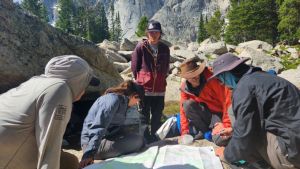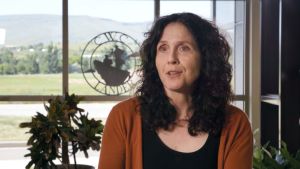
GEOBRIDGES at Central Wyoming College is gaining momentum in its second summer of using Advanced Technological Education grant funds to provide stipends for students to assist with applied geospatial science and technology (GIST) research and monitoring in the Wind River Mountains.
In 2023, 20 students participated; 30% were Native Americans. There are Eastern Shoshone and Northern Arapaho tribal communities in the service area of the college, which is a Native American-Serving Non-Tribal Institution.
This summer there is a waiting list for GEOBRIDGES, which teaches geospatial information science (GIS) and other skills ranging from first aid to data analysis in credit courses that apply toward CWC's Expedition Science certificate and associate degree. This credential qualifies students for entry-level technician roles with the U.S. Forest Service, local tribes, and private employers. The condensed format also accelerates associate degree completion.
“We're putting the capstone first in a sense. They're getting these amazing opportunities that are usually for advanced undergraduates and graduate students. And as they're doing these projects, they're going to conferences and presenting. They're writing hypotheses. They're doing scientific research projects,” Jacki Klancher said during a recent interview. Klancher is the director of Research and Innovation at CWC’s Alpine Science Institute, an environmental health and science professor, and principal investigator of GEOBRIDGES.
Aside from the significant knowledge boost, the GEOBRIDGES project (National Science Foundation Award 2202230) provides students with comprehensive access to expensive wilderness learning experiences that are usually out of reach for individuals who have to work summer jobs or who have expended their financial aid during fall and spring semesters. CWC and other funders (listed at the end of the article) cover participants’ tuition for their summer courses and expedition-related expenses.
In the ATE Impacts Video featuring GEOBRIDGES, Klancher says, “I’m really proud to be able to offer something that’s so practical that you can apply it with a two-year degree or you can build on it and take it where you want to. I feel great satisfaction that when they leave at the end of the summer, their pockets won’t be empty and their minds will be full.”

The ATE Impacts Video series at https://ateimpacts.net/impacts/videos added four videos in May in conjunction with the release of the book ATE Impacts 2024-2025: 30 Years of Advancing Technician Education. The cinematic videos were created by Vox Television in partnership with the Internet Scout Research Group, part of the Computer Sciences Department of the University of Wisconsin-Madison.
Both the book and the videos feature ATE community members—students, industry partners, instructors, and administrators—explaining the ATE program’s positive impact on their lives and the people served by the NSF grant-funded programs across the United States. The book and video series were prepared with NSF support under grant 2033738.
Klancher explained that the curriculum for GEOBRIDGES and the stipends it provides overlap with several other outdoor learning experience programs that the college offers with support from other funders. As a result of these partnerships students have their choice of four summer outdoor experiences with paid internships in:
- Glaciology
- High-Elevation Archeology
- Environmental and Wilderness Monitoring
- Cultural Resources Monitoring
To prepare students to work in the wilderness they also take an interpretive guide course that emphasizes communication and leadership skills and a safety course that focuses on the skills that technicians use when they are in the back country for weeks at a time. Students may also choose from introductory courses in uncrewed aircraft (also known as drones), land management, and data analysis.

Because of safety considerations that go along with working in the back country, where bears, lightening, and other risks are part of the river and mountain environments, each multi-week learning experience is limited to 14 students and requires two, and often three, faculty members.
Consequently not every student takes every option. However, but most of the participants have multiple hands-on experiences that Klancher said give them “an unbelievable skill set for one summer.”
Her hope is that the intellectually and physically engaging adventures of GEOBRIDGES encourage students to persist in the fall and spring in challenging semester-long courses in geographic information systems, cartography, and remote sensing back on campus.
Klancher credits the program’s successful recruiting efforts to word-of-mouth promotion by happy students—who are the best recruiters—and these colleagues: Dr. Tarissa Spoonhunter, a CWC adjunct faculty member; Eric Bennett, CWC assistant professor for Native American and Indigenous Studies; and Rory Tendore, CWC coordinator of American Indian Student Success.
The 30% Indigenous student participation in GEOBRIDGES far exceeds the 13% of CWC’s 1,900 general enrollment students who are Native Americans.
The geospatial information science and technology skills that CWC teaches through GEOBRIDGES are used in natural resource management, urban and rural planning, agriculture, and trail building careers.
Klancher said, “There are a zillion jobs, but students have to be advised and know what they have and know, [and] how to look for those jobs ... I think we're still struggling to show people the pathways.” Her next big goal for GEOBRIDGES is further refinement of the combination of technical preparation and computer software instruction.
Klancher is grateful for all the partners and funders who are collaborating to make these dynamic experiences available to a diverse population of students.
She explained that the University of Wyoming NSF EPSCOR Wy-ACT (Wyoming Anticipating Climate Transitions) program is the primary funder for the field expeditions and students’ travel to conferences. This funding supports field logistics, such as food, research supplies, emergency communications, and expedition gear. And, it provides field faculty with the appropriate risk management experience to run expeditions at high elevations in remote areas.
The expeditions are also supported by the following: WY NASA Space Grant Consortium; the NSF-funded Rocky Mountain Alliance for Minority Participation (through the Louis Stokes Alliance for Minority Participation); the National Institute of Health (NIH) funded Wyoming IDeA Networks for Biomedical Research Excellence (WY INBRE) program; and the CWC Foundation.
“With support from other NSF, NASA, and NIH programs, GEOBRIDGES has provided funding and support to allows us to collaborate with potential employers and industry to transform our geospatial information science and technology curriculum; create paid internships with critical partners and employers such as the U.S. Forest Service; increase our frequency of contact and seek input from our American Indian studies and Indigenous colleagues to discuss student needs; and provide student internship support for the time they spend working on research and monitoring projects,” Klancher explained in an email.
 Subscribe
Subscribe


 See More ATE Impacts
See More ATE Impacts
Comments
There are no comments yet for this entry. Please Log In to post one.